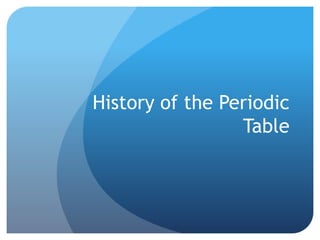History of the Periodic Table
•
4 likes•1,807 views
History of the Periodic Table
Report
Share
Report
Share

Recommended
Recommended
More Related Content
What's hot
What's hot (20)
Periodic calssification of elements ncert shashikumar b s

Periodic calssification of elements ncert shashikumar b s
Similar to History of the Periodic Table
Similar to History of the Periodic Table (20)
giorgiana1976 Teacher Doctorate Debater, Expert Since antiquity, aro.pdf

giorgiana1976 Teacher Doctorate Debater, Expert Since antiquity, aro.pdf
Recently uploaded
Mehran University Newsletter is a Quarterly Publication from Public Relations OfficeMehran University Newsletter Vol-X, Issue-I, 2024

Mehran University Newsletter Vol-X, Issue-I, 2024Mehran University of Engineering & Technology, Jamshoro
Recently uploaded (20)
Micro-Scholarship, What it is, How can it help me.pdf

Micro-Scholarship, What it is, How can it help me.pdf
ICT Role in 21st Century Education & its Challenges.pptx

ICT Role in 21st Century Education & its Challenges.pptx
On National Teacher Day, meet the 2024-25 Kenan Fellows

On National Teacher Day, meet the 2024-25 Kenan Fellows
Basic Civil Engineering first year Notes- Chapter 4 Building.pptx

Basic Civil Engineering first year Notes- Chapter 4 Building.pptx
Python Notes for mca i year students osmania university.docx

Python Notes for mca i year students osmania university.docx
Unit-IV; Professional Sales Representative (PSR).pptx

Unit-IV; Professional Sales Representative (PSR).pptx
Kodo Millet PPT made by Ghanshyam bairwa college of Agriculture kumher bhara...

Kodo Millet PPT made by Ghanshyam bairwa college of Agriculture kumher bhara...
History of the Periodic Table
- 1. History of the Periodic Table
- 2. The Modern Periodic Table of Elements
- 3. Origins of the Periodic Table Aristotle – four “roots” Earth, Air, Water, Fire Plato renamed the “roots” and called them elements The beginnings of the idea that there were only a limited number of basic building blocks of all substances
- 4. The next 1500 years… The scientific world remained stagnant until the Age of Enlightenment In 1649 Hennig Brand discovered P while trying to find the Philosopher’s Stone This new substance could not be broken down into anything more basic Questions began to be asked about the four elements and what it really meant to be an element In 1661 Robert Boyle defined an element as “a substance that cannot be broken down into a simpler substance by a chemical reaction”
- 6. Antoine-Laurent de Lavoisier Wrote the first textbook on chemistry - Traité Élémentaire de Chimie – in 1789 Classified elements into four groups Elastic Fluids – light, caloric, O, N, H Nonmetals – S, P, C, HCl, HF, H3BO3 Metals – Sb, As, Ag, Bi, Co, Cu, Sn, Fe, Mn, Hg, Mo, Ni, Au, Pt, Pb, W, Zn Earths – lime, MgO, BaO, SiO2 While Lavoisier classified elements, there was no organization to his table based on properties of the elements.
- 8. Johann Wolfgang Döbereiner In 1817, Döbereiner began the first attempt to classify and list the elements based on certain properties. He organized sets of 3, or triads of, elements in which the atomic mass of the middle element was the average of the other two. This was the first hint at the groups we see in the modern table.
- 9. Classification of Elements In 1862, Alexandre-Emile Béguyer de Chancourtois, a French geologist devised a complicated way of arranging the elements around a cylinder that correctly predicted periodicity In 1865, John Newlands identified what he called the “Law of Octaves” according to which elements behaved much like musical notes and repeated a pattern with every octet By 1869, 63 separate elements had been identified, and trends were beginning to be noticed
- 11. Dimitri Mendeleev Mendeleev was a Russian chemist He arranged the elements according to atomic mass and discovered that if listed in rows and columns certain trends became clear. Elements with similar properties either have atomic masses that are nearly equal (elements which are side by side - Pt, Ir, Os) or increase in a certain increment (elements which are in a single column – K, Rb, Cs) With his table, Mendeleev was able to accurately predict undiscovered elements and their properties
- 12. Henry Moseley In 1914, Moseley, a British scientist, began performing experiments on elements to better understand their atomic structure He found that different elements responded differently to bombardment with x-rays and that they each had a unique frequency That frequency corresponded to the number of protons in the atom. Introduced atomic number (Z)
- 13. Glenn Seaborg During research related to the Manhattan Project, Seaborg proposed a change to Mendeleev’s structure. The series of 14 elements following Actinium and Lanthanum were left out of Mendeleev’s table because they really didn’t fit. Seaborg proposed that they belong to their own series due to their atomic/electronic structure (f orbitals)
Editor's Notes
- Grey – before 1800 Blue-green – 1800-1849 Dark purple – 1850-1899 Purple – 1900-1949 Light purple – 1950-1999
